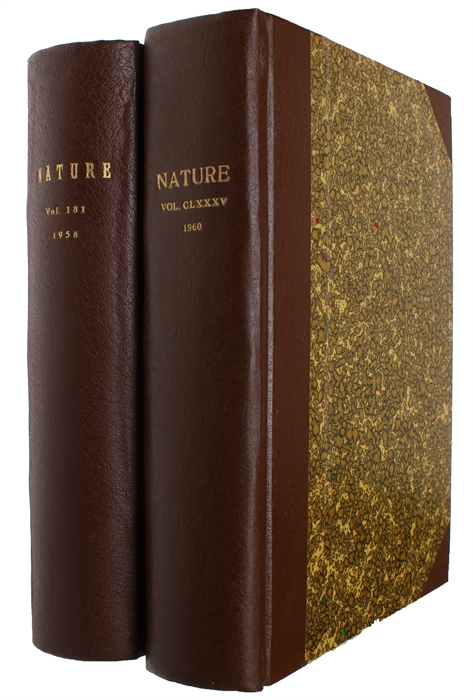KENDREW, J. C. ET AL.
A Three-Dimensional Model of the Myoglobin Molecule Obtained by X-ray Analysis [in Nature 181, 1958] (+) Structure of Myoglobin: A Three-Dimensional Fourier synthesis at 2 Å Resolution [in Nature 185, 1960].
London, Macmillian and Co, 1958 & 1960.
Roayl8vo. 2 volumes, bound in contemporary half cloth with gilt lettering to spines. Stamps to front free end-paper and first leaf of each issue. In "Nature", vol. 181 & 185, 1958 & 1960, entire volumes offered. A fine set. [Nature 181, 1958:] pp. 662-666. [Nature 185, 1960:] pp. 422-27. [Entire volumes. CXLII, (2), 936 pp; LXXV, (1), 952 pp.].
First appearance of both papers in which the first three-dimensional model of a protein was presented, essential knowledge for progress in curing human diseases, thus laid the foundation for all structural biology. Kendrew was furthermore one of the first to use a computer in analyzing the data produced by x-ray diffraction. For his essential discovery Kendrew was awarded the Nobel Prize in Chemistry in 1962. The discovery is widely regarded as being one the most important in the second half of the 20th century within biology and chemistry. "The first dramatic but hard-won success of the approach [in understanding molecules], the determination of the three-dimensional structure of a protein called myoglobin, was announced in 1958 [in the present paper]. The findings laid the foundation for the age of structure in biology: [.] the paper was the outcome of a truly Herculean task. (Garwin, A century of Nature: twenty-one discoveries that changed science and the world, 2003, Pp. 87-88). The papers they produced (both offered here) are "the outcome of a truly Herculean task. When the project began, there were no automated instruments or digital computers for generating or analyzing the huge amounts of data necessary. Every step had to be carried out by hand. many repeated thousands of times" (A Century of Nature, p. 89) “After the war, John Kendrew, a physical chemist who had occupied high offices in operational research during the war and, while on a common mission in Ceylon, had been convinced by Bernal of the promises of protein crystallography, joined Perutz to do a PhD. (Although working closely with Perutz, Kendrew was officially supervised by William T. Taylor, head of the crystallography division at the Cavendish; like most professional crystallographers Taylor regarded protein crystallography as a hopeless undertaking, but still accepted the formal agreement.) Kendrew first embarked on a comparative analysis of fetal and adult hemoglobin, but later switched to the simpler protein myoglobin, the oxygen carrier in muscle.” (DSB) Perutz now managed to attach a heavy atom (mercury) to the hemoglobin molecule. From the difference produced in the diffraction pattern he was able to deduce the phase of the reflections. The method had been known since the 1930s, but it had only been used for small molecules. Although the suggestion to apply the method to proteins dated from the same period, its applicability had not been proved. “The problem consisted, firstly, in finding a heavy metal compound that could be attached to a specific site without altering the arrangement of the other atoms in the molecule and, secondly, in estimating with sufficient accuracy the overall changes in intensity produced by the heavy atoms. In Bragg’s judgment, Perutz’s skill in this last respect was “probably unique” at the time (Bragg, 1965, p. 12). To this day, the isomorphous replacement method is considered the key method to determine the crystal structure of proteins. Kendrew, working on the smaller myoglobin molecule, was the first to take full advantage of the new method. In 1958, he presented the first model ever of a globular protein derived by direct structure determination. The model showed the general outline of the molecule; a second model at atomic resolution followed two years later. In the same year Perutz presented the first model of hemoglobin at 5.5 Ångstrøm. Its four subunits proved to be closely related to the myoglobin molecule. The white-and-black disk model built of thermosetting plastic is still widely reproduced.” (DSB) The determination of any of these protein structures could not have been contemplated without the use of ever more powerful electronic computers. Perutz initially distrusted the new calculating devices and resisted resorting to the experimental digital computers developed at the nearby Mathematical Laboratory. Eventually he came around to recognize their usefulness, but he freely admitted that he was always hopeless at computing. He never made use of the machine himself and rather left this part of the work to the younger people in his group. Perutz and Kendrew shared the 1962 Nobel Prize for Chemistry for their work on the structure of proteins.” (DSB) Garrison & Morton: 6911 & 6912
Order-nr.: 59914


![A Three-Dimensional Model of the Myoglobin Molecule Obtained by X-ray Analysis [in Nature 181, 1958] (+) Structure of Myoglobin: A Three-Dimensional Fourier synthesis at 2 Å Resolution [in Nature 185, 1960].](/images/product/59914b.jpg)